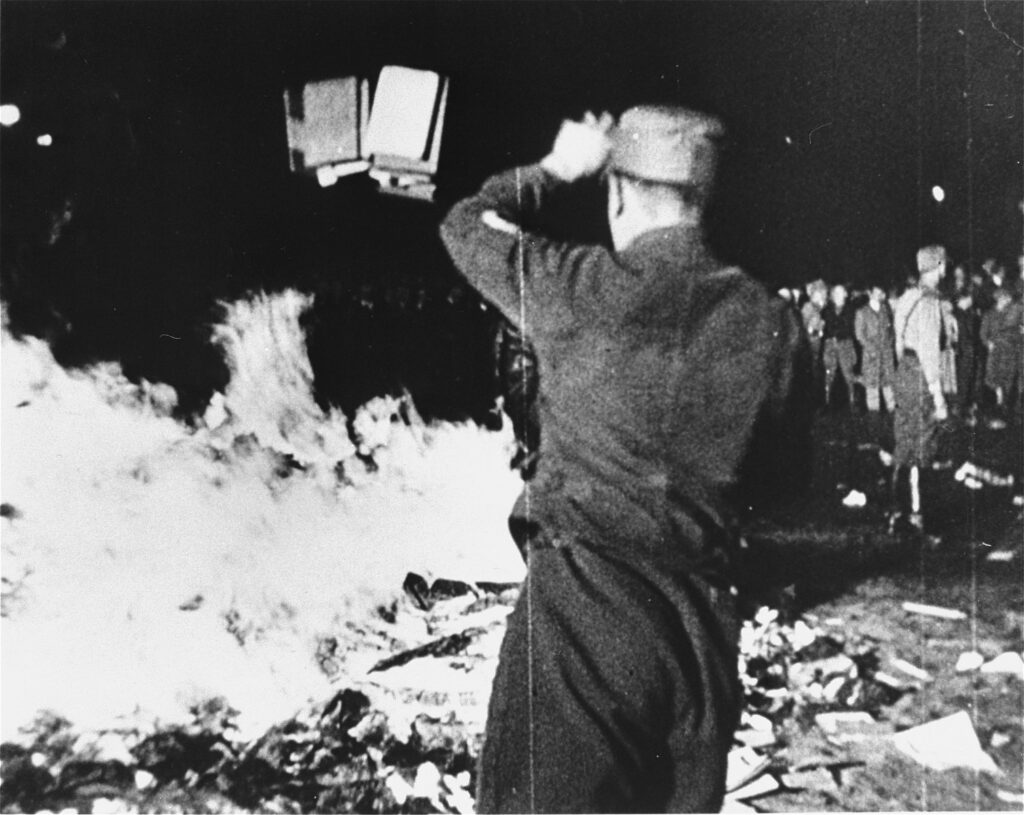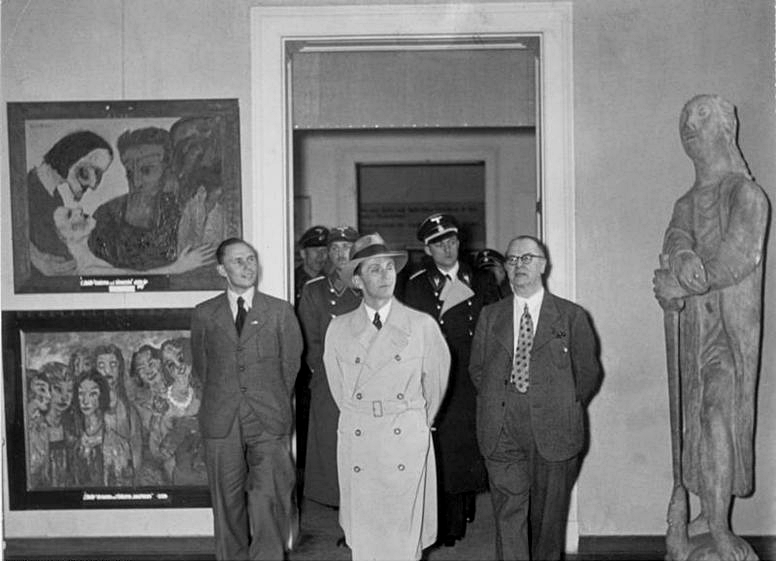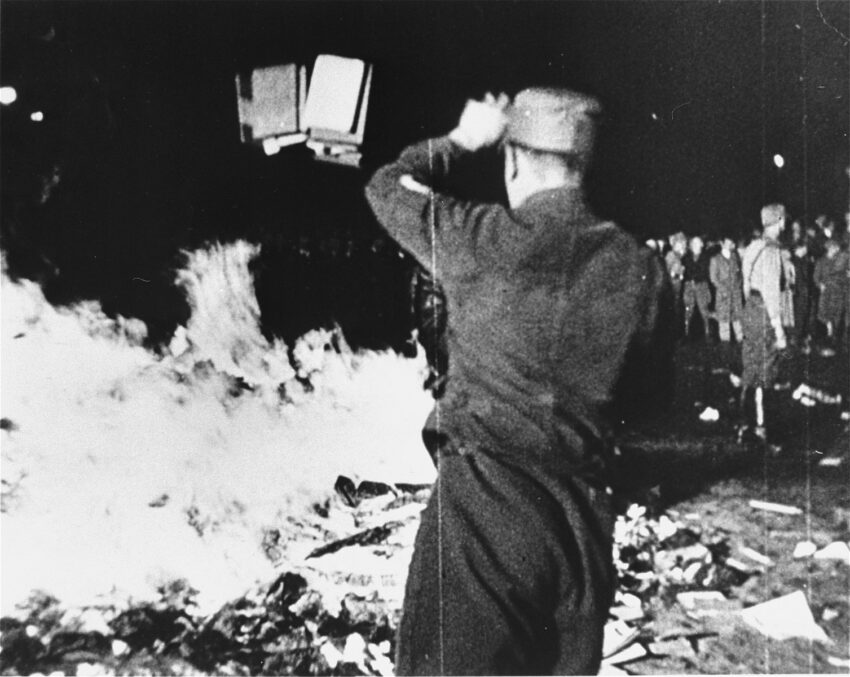Within the Third Reich’s first few years, the arts and literature received a great amount of regulation and change in policies. In 1933 after becoming chancellor of Germany, Adolf Hitler and the Nazis sought to create a “coordination” [Gleichschaltung] of German culture and literature as part of the ideological and racial awakening of their newly crafted national community [Volksgemeinschaft]. This coordination included purging German art, music, and literature of all “un-German” characteristics and elements. The Nazis attempted to censor and destroy works of music, art, and literature through cultural policies that privileged certain kinds of arts, but the inconsistency and incoherence of those policies undermined their ability to make clear distinctions between “German” and “degenerate” works and to conform the cultural sphere to Nazi ideology.
The first major example of this coordination was the nationwide book-burning events known as the operation “Against the Un-German Spirit”. Created by the National Socialist German Students’ League (NSDStb), book-burnings occurred across a number of university cities throughout May and June of 1933. The largest of these took place on Berlin’s Opera Square on May 10, 1933. Approximately 20,000 books, written by various authors including Karl Marx, Sigmund Freud, and Kurt Tucholsky, were burnt.

Member of the SA throws books into the fire, Opernplatz, May 1933. Source: Wikimedia Commons (Public Domain)
While the infamous book-burning events were conducted by students rather than the government, it anticipated the strict Nazi cultural policies that would soon follow. Some even argue that with this event, there was not only a “symbolic and ideological but also a strong circumstantial connection between the burning of books and the burning of men” (Hill, 33). The book burnings were ultimately just an opening for the horrors to follow, rooted in the destruction of the “un-German spirit” and translated into mass cultural policies.
In March, 1933, Hitler appointed his close friend and colleague, Joseph Goebbels, to the position of Reich Minister for Popular Enlightenment and Propaganda. By September, Goebbels created the Reich Chamber of Culture [Reichskulturkammer], an organization which made membership mandatory for all artists, musicians, writers, performers, and others who wished to continue working in the cultural sphere. Membership was based solely on race and political ideology which effectively excluded and prevented Jews and all those deemed a ‘threat’ to the Third Reich’s agenda from working or publishing.
The Reich Chamber of Culture’s goal aimed towards a complete process of the “Aryanzation” of art. This process involved labeling the work of Jews, socialists, and all those who refused to conform as “degenerate.” The Manual of the Reich Chamber of Culture laid out the very specific nature and functions of its sub-chambers in the cultural field. Extracts from the Manual of the Reich Chamber of Culture (1937) reveal the mass amount of censorship that was placed on the arts in efforts to control and shape not only the quality and characteristics of the arts to align with Nazi ideology, but also to influence how the public perceived it.
Wilhelm Furtwängler, a conductor who was head of the Berlin State Opera and later named Vice President of the Reich Chamber of Music, openly addressed Goebbels in a letter and voiced his distaste of this new policy. Furtwängler stressed the necessity in keeping art separate from politics and respecting artists from Jewish background. He suggested that the fight be against artists who exemplify the “rootless, subversive, leveling, destructive spirit” rather than against real artists with a creative mind. Goebbels, in response, claimed art was “already political” and therefore it could not be made separate. In addition, he stressed ‘real’ artists were ‘pure’ Germans — a growing anti-semitic sentiment during this radicalization period — whose work needed to be promoted and supported.
With efforts to re-define and praise “German” art, Hitler opened the House of German Art in July of 1937 in Munich. The museum was built on the former ground of the Glass Palace which was completely destroyed by a fire, along with its large exhibition of German Romantic paintings, in 1931. Its first show, the “First Great German Art Exhibition,” was the first of eight annual shows that displayed works by those who exemplified “pure, Aryan” background. The exhibition was opened one day before the “Degenerate Art” exhibition yet during its first four months saw an average of only 3,200 visitors a day compared to the “Degenerate Art” exhibition which drew in an average of more than 20,000 visitors a day.
On the opening day, Hitler gave a speech praising the German artwork inside and mourning the loss of the “genuine, German” paintings from the site years before. He claimed its opening was “the beginning of the end of German artistic foolery and thus of the cultural destruction of our people.” The number of works displayed totaled around 900, which included depictions of workers and heroes, genre scenes, idealized landscapes, and portraits of “Aryan” people. An illustrated report published in the Berliner llustrirte Zeitung [Berlin Illustrated Newspaper] in July of 1937 revealed some of the featured works included in the museum that stood out as “setting the direction of German art.” Each illustration was accompanied by a caption full of praise and explanation on how it met the National Socialist aesthetic criteria. The “Degenerate Art” exhibition displayed around 650 works chosen out of a collection of 16,000 specifically hand-picked works by painter Adolf Zieglar, president of the Reich Chamber of Visual Arts.
While these two exhibitions were created to demonstrate the difference between “German” art versus “degenerate,” there were many inconsistencies and incoherences present stemming from the cultural policy itself. First, membership in the Reich Chamber of Culture was often controversial which could be seen in the example of German Expressionist painters. Their work was often described as “foreign, Bolshevist, Jewish, and degenerate” by right-wing critics, yet they also had influential right-wing advocates such as president of the National Socialist German Student League, Otto Schreiber, and Goebbels who collected works by artists Emil Nolde and Ernst Barlach in the early years of the Reich (Segal, 50). Modern artists such as Emil Nolde, one of the most represented artists in the “degenerate” exhibit, Max Pechstein, and Ernst Ludwig Kirchner are all examples of modern artists who supported the Nazi regime very publicly yet still became victims to its policy. In addition, modern art was characterized as “Jewish or communist” yet in reality, most modern German artists were neither. Interestingly enough, only two of the German artists represented in the “Degenerate Art” exhibition were “ethnically Jewish: Ludwig Meider and Otto Freundlich” (Segal, 56).

Incoherency was present on the walls of the “Degenerate Art” exhibition as the walls were marked with insults that were not actually applicable for the work it was condemning. This was heavily seen in the example of Expressionist sculptor, Wilhelm Lehmbruck’s Large Kneeling Woman. Large Kneeling Woman, a sculpture created in 1911, was put on display in the “Degenerate Art” exhibition in 1937 with the words “They had four years’ time” [“Sie hatten vier Jahre Zeit”] written on the wall behind it. This insult is presumably referring to the idea that after four years of National Socialist regime, these ‘degenerate’ artists still failed to conform their work to meet the new cultural polices and aesthetics. This insult is incoherent with Lehmbruck and his work, especially his sculpture on display, as in 1911 Lehmbruck committed suicide. Therefore, the insult on the wall is not only incoherent but also completely inapplicable to his work.
The changing selection of artwork for both exhibitions also prompted further inconsistencies and incoherences to arise. Certain works by Franz Marc, Ernst Barlach, and Käthe Kollwitz were displayed in the “Degenerate Art” exhibition only to later be removed when the exhibition traveled to Berlin as they were “no longer considered unambiguous examples of degenerate art” (Segal, 55). On the contrary, some artworks that were presented as “German” at earlier National Socialist exhibitions were later featured in the “Degenerate Art” exhibition. These unclear distinctions were even furthered when sculptor Rudolf Belling’s works were featured at both exhibitions. Ultimately, it was evident that there was a wide incoherency in the cultural policy in claiming great art to be of the “German” race and alignment with political ideology, when in reality, art was elusively judged on artistic style which then would lead to the labeling of ‘degenerate.’
Similarly to art, inconsistencies continuously arose in the musical world of the Third Reich when determining who would be labeled as “degenerate.” While Jews and communists remained the main target, some “pure Aryans” such as Anton Webern and Heinrich Mann were branded as “degenerate” too (Potter, 96). In addition, it was nearly impossible to exile all Jewish musicians since exceptions were often made for artistic reasons. The phrase “I will determine who is Jew” almost became the new policy as leaders such as Göring and Goebbels made various exceptions and granted permits to certain Jews, such as conductor Leo Blech and singer Alexander Kipnis, “as they concentrated on getting the best and brightest stars for their ensembles” within their own musical institutions (Potter, 96). Through these exceptions and examples, it was apparent that while the Nazis desired and were successfully able to purge the musical community, they were very inconsistent in doing so.
The Nazis were adamant about banning and creating blacklists for music that was inconsistent with their ideology or written by Jews as seen in the “blacklist of undesired musical works” published in March of 1939. It was not enough, however, to prevent and ban those deemed “degenerate” from composing music. The “Aryanization of music” was a common process where the Nazis attempted at banishing any trace of Judaic influence from musical pieces. Even the most well-known German composers, such as Felix Mendelssohn, Johannes Mozart, and Georg Handel, were not exempt from this process.
While the Nazis made extreme efforts to ban or re-work some of the world’s most renowned composers’s works, there were many inconsistencies that emerged through this specific task. Mendelssohn, a composer of Jewish birth, was faced with a great amount of anti-semitic discrimination. Hans Joachim and Richard Wagner, both well-known musicologists and composers at the time, published works in which they argued Mendelssohn’s racial origin was to blame for his lack of musical genius. While these opinions were common, Mendelssohn’s “degenerate” work was still increasingly difficult to live up to as composer’s were faced with and failed at the task of providing alternative compositions to his incidental music to Shakespeare’s A Midsummer Night’s Dream. The national ‘need’ to replace Mendelssohn’s work was therefore met with the reality that his work could not so easily be replaced.
In addition, there were often blurred lines on how to assess music made out of a collaboration between an ‘Aryan’ and a Jew as seen with composers Franz Schubert, Robert Schumann, and Mozart. Schubert’s Schwanengesang and Schumann’s Liederkreis Op. 24 both had poetry set by Jewish poet, Heine. Critic Karl Blessinger revealed just how inconsistent the Nazis were with handling collaborated music as he “damned all poetry written by Jews as worthless” and to be forgotten out of existence, yet made excuses for Schubert and Schumann’s collaborations claiming “these masters did not recognize the grimace of the Jew” and therefore, there was no reason to remove their pieces from being performed publicly (Levi, 20). Mozart faced similar controversy as he collaborated with a Jew on three famous operas: Cost fan tutte, Le nozze di Figaro, and Don Giovanni. The Nazis knew banning these operas would create an uproar from the public so they refused to do, despite strongly disavowing any music to stem from Judaic influence.
Handel also faced controversy as many of his oratorio texts were based upon excerpts from the Old Testament. Many felt the need to re-work Handel’s oratorios so much to the point that Goebbels had to step in to prevent it from continuing. Alfred Rosenberg, an ideologue of the Nazi party, argued Handel’s work must be re-worked and led the fight against Goebbels who argued it would be a betrayal to German history. This strong disagreement between two prominent Nazi ideologues, Rosenberg and Goebbels, ultimately demonstrates how incoherent and inconsistent artistic policy was in Nazi Germany. Furthermore, during a time when the country emphasized its desire for and stressed the importance of national pride, it saw itself inconsistently finding a need to replace and re-work some of the finest works of renowned German composers.
The “Degenerate Music” exhibition, opened in 1938, is another example of the incoherency and inconsistency between Nazi ideology and implementation. It was precedented by the Reich Music Days, a week-long public event full of festivities that included concerts of ‘pure’ German music and ideological lectures in Düsseldorf. While it aimed at distinguishing good “German” music from its Jewish and foreign threats, the best it could provide was that German music was distinct for its “depth, clarity, and that “certain something” that made it recognizably German” (Potter, 92). The exhibit similarly presented a faulty line without recognizing a distinct difference between good and bad. Rather, it focused more on fear of ‘the other’ and threw together a “confusing mixture of anything construed as alienating, intellectual, sarcastic, erotic, socialist, capitalist, or American” (Potter, 92). The cover of the title page of the exhibition guide depicted this fear as it was an illustration of a black saxophonist with the Star of David on his lapel. This illustration represented ‘racial otherness’ and the fear of American and jazz influence through its depiction of a black musician holding a saxophone. In addition, the Star of David was meant to represent the manipulative power and destructiveness of the Jewish impact on musical culture.

More incoherences within the exhibition were seen in that most of the composers represented were easy targets as they had all already died or emigrated by the time it had opened. ‘Aryan’ composers such as Ernst Krenek and Kurt Weill were targeted for either “satirizing capitalism” or collaborating with Jews such as in Krenek’s opera Jonny spielt auf! despite their major successes (Potter, 93). In addition, one of Ignor Stravinsky’s works, L’histoire du soldat, was referenced as “degenerate” despite Stravinsky being named as a “model for young composers of the Third Reich” and all of the great success he had been experiencing in Germany at the time (Potter, 95).
Jazz was also seen as an easy target in the exhibit yet its fate in the Third Reich remained inconsistent with its criticisms. Jazz came to symbolize “foreign corruption” in the minds of youth leaders, music critics, and musicians who feared foreign competition (Potter, 95). While Nazis attempted at banning jazz from being broadcast on radio programs or publicly performed, it proved to be much more difficult to control and therefore lived on in German society in a variety of ways (Kater, 17). The public also threatened to listen to jazz through foreign stations which prompted the Nazis to be more lenient with their cultural policy. Despite the negative portrayal of jazz, it continued to thrive off the radio as well in nightclubs. The lenience the Nazis had with jazz overall represented their inconsistency in upholding cultural policy to please the public. Their fear of public uproar exemplified their weak ability to exert confidence in their own polices. Furthermore, their inability to accurately describe music or provide guidelines for great “German” music represents that just as music is very elusive, so were their polices.
Ultimately, the Nazi’s ability to conform the cultural sphere to its ideology was undermined by their incoherent and inconsistent cultural policies. Due to the lack of a clear artistic policy, distinctions between “German” and “degenerate” artistic works were elusive and based mostly upon a fluctuating opinions of Nazi ideologues. While the Nazis made great efforts to re-work, ban, and censor pieces, as well as succeeded in eradicating the musical community of those unwanted, they were unable to fulfill a complete conformity of the arts to ideology as seen through their inconsistent implementation.
For Further Reading:
Hill, Leonides E. “The Nazi Attack On ‘Un-German’ Literature, 1933-1945.” The Holocaust and the Book: Destruction and Preservation, by Jonathan Rose, University of Massachusetts Press, 2008, pp. 9–46.
Kater, Michael H. “Forbidden Fruit? Jazz in the Third Reich.” The American Historical Review, vol. 94, no. 1, 1989, pp. 11–43.
Levi, Erik. “The Aryanization of Music in Nazi Germany.” The Musical Times, vol. 131, no. 1763, 1 Jan. 1990, pp. 19–23. JSTOR.
Potter, Pamela M. “Music in the Third Reich: The Complex Task of ‘Germanization.’” The Arts in Nazi Germany Continuity, Conformity, Change, by Jonathan Huener and Francis R. Nicosia, Berghahn Books, 2009, pp. 85–100.
Segal, Joes. “National and Degenerate Art The Third Reich.” Art and Politics: between Purity and Propaganda, AUP, 2016, pp. 45–59.
Written by Meghan Long, Music and English Double Major, Loyola Marymount University, 2019.
